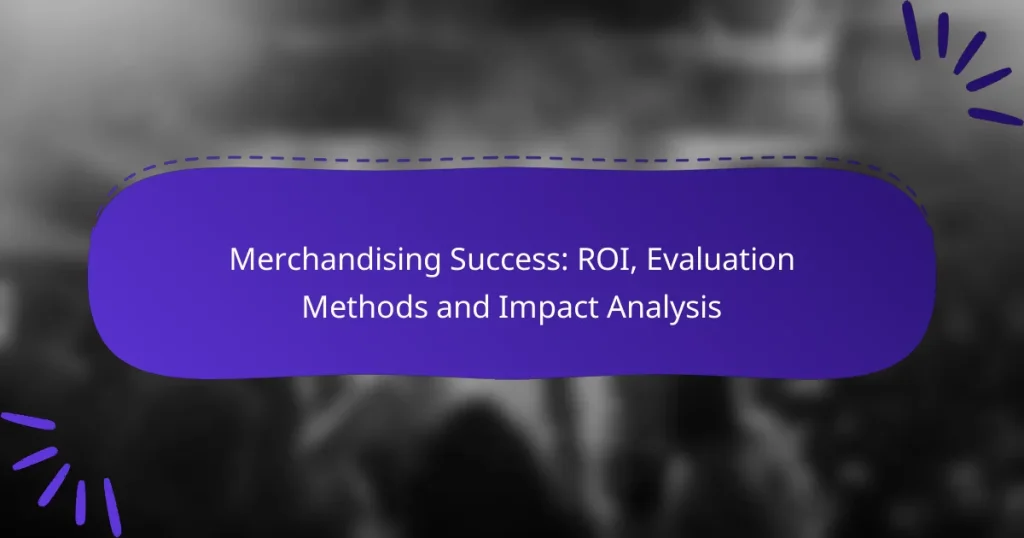Measuring campaign success in e-commerce is essential for understanding performance and profitability. By analyzing key metrics such as sales figures, customer engagement, and return on investment, marketers can gain valuable insights into their campaigns. Utilizing effective tracking tools allows for a deeper understanding of user behavior and conversion rates, ultimately guiding future strategies for improved results.
Merchandising Success: ROI, Evaluation Methods and Impact Analysis
Campaign Performance: Analytics Tools, Measurement Techniques and Insights
Fan Engagement: Customer Lifetime Value, Measurement Techniques and Benefits
How to measure campaign success in e-commerce?
Measuring campaign success in e-commerce involves analyzing various metrics that reflect performance and profitability. Key indicators such as sales figures, customer engagement, and return on investment provide insights into how well a campaign is performing.
Key performance indicators (KPIs)
Key performance indicators (KPIs) are essential metrics that help evaluate the effectiveness of an e-commerce campaign. Common KPIs include sales revenue, website traffic, and customer retention rates. Focusing on the right KPIs allows businesses to track progress and make informed decisions.
To select relevant KPIs, consider your campaign goals. For instance, if the goal is to increase brand awareness, metrics like reach and impressions may be more relevant than direct sales figures.
Return on investment (ROI)
Return on investment (ROI) measures the profitability of a campaign relative to its costs. To calculate ROI, use the formula: (Net Profit / Cost of Investment) x 100. A positive ROI indicates that the campaign generated more revenue than it cost, which is crucial for sustainability.
For e-commerce, aim for an ROI of at least 20-30% to ensure that your marketing efforts are yielding satisfactory returns. Regularly reviewing ROI helps identify which campaigns are worth continuing or adjusting.
Customer acquisition cost (CAC)
Customer acquisition cost (CAC) is the total cost of acquiring a new customer, including marketing expenses and sales efforts. To calculate CAC, divide total marketing expenses by the number of new customers acquired during a specific period. Keeping CAC low is vital for maintaining profitability.
In e-commerce, a CAC that is significantly lower than the customer lifetime value (CLV) indicates a healthy business model. Aim for a CAC that is less than one-third of the CLV to ensure long-term success.
Conversion rate
The conversion rate is the percentage of visitors who complete a desired action, such as making a purchase. To calculate it, divide the number of conversions by the total number of visitors and multiply by 100. A higher conversion rate signifies effective marketing and user experience.
In e-commerce, a conversion rate of 2-5% is generally considered average, while rates above 5% are excellent. To improve conversion rates, optimize product pages, streamline the checkout process, and use targeted promotions.
Sales growth
Sales growth measures the increase in sales over a specific period, indicating the effectiveness of marketing campaigns and overall business health. To calculate sales growth, subtract the previous period’s sales from the current period’s sales, divide by the previous period’s sales, and multiply by 100.
Consistent sales growth of 10-20% annually is often a good benchmark for e-commerce businesses. To drive sales growth, focus on expanding product offerings, enhancing customer service, and leveraging data-driven marketing strategies.
What tools can help track campaign performance?
Several tools can effectively track campaign performance, providing insights into user behavior, engagement, and conversion rates. Utilizing these tools can help marketers optimize their strategies and improve overall results.
Google Analytics
Google Analytics is a powerful tool for tracking website traffic and user interactions. It provides detailed reports on user demographics, behavior, and conversion paths, helping you understand how visitors engage with your campaigns.
To get started, set up goals that align with your campaign objectives, such as newsletter sign-ups or product purchases. Regularly review metrics like bounce rates and session duration to identify areas for improvement.
HubSpot
HubSpot offers a comprehensive marketing platform that includes tools for tracking campaign performance across multiple channels. It integrates email marketing, social media, and content management, allowing for a holistic view of your marketing efforts.
Utilize HubSpot’s analytics dashboard to monitor key performance indicators (KPIs) like lead generation and customer acquisition costs. Take advantage of A/B testing features to refine your messaging and improve engagement rates.
SEMrush
SEMrush is primarily known for its SEO capabilities, but it also provides valuable insights into campaign performance through its advertising tools. It allows users to analyze competitors and track keyword performance, which can inform your campaign strategies.
Use SEMrush to evaluate the effectiveness of your paid ads by monitoring click-through rates (CTR) and return on ad spend (ROAS). This can help you adjust your bidding strategies and optimize your ad placements.
Facebook Ads Manager
Facebook Ads Manager is essential for tracking the performance of your advertising campaigns on Facebook and Instagram. It provides detailed analytics on ad reach, engagement, and conversion rates, enabling you to assess the effectiveness of your ads.
To maximize your results, regularly analyze audience insights and adjust your targeting based on performance data. Experiment with different ad formats and placements to find the most effective combinations for your campaigns.
How to analyze campaign data effectively?
To analyze campaign data effectively, focus on key metrics that align with your campaign goals. This involves breaking down data into actionable insights that can guide future strategies.
Data segmentation
Data segmentation involves dividing your audience into distinct groups based on shared characteristics. This allows for more targeted analysis and helps identify which segments respond best to your campaigns.
Consider segmenting by demographics, behavior, or engagement levels. For example, you might analyze responses from different age groups or geographic locations to tailor your messaging.
Attribution modeling
Attribution modeling helps determine which channels or touchpoints contribute most to conversions. By understanding the customer journey, you can allocate resources more effectively across channels.
Common models include first-touch, last-touch, and multi-touch attribution. Each has its strengths; for instance, multi-touch provides a comprehensive view but can be complex to implement.
Trend analysis
Trend analysis focuses on identifying patterns over time within your campaign data. This can reveal insights into seasonality, changing consumer preferences, or the effectiveness of different strategies.
To conduct trend analysis, compare data across various time frames, such as weekly or monthly. Look for consistent patterns that can inform future campaigns, like increased engagement during specific months.
What are common pitfalls in measuring success?
Common pitfalls in measuring campaign success include overlooking important data types, concentrating on superficial metrics, and failing to incorporate customer insights. These mistakes can lead to skewed interpretations and ineffective strategies.
Ignoring qualitative data
Qualitative data, such as customer sentiments and experiences, provides valuable context that quantitative metrics often miss. Ignoring this type of data can result in a narrow understanding of campaign effectiveness. For instance, while sales numbers may be strong, negative customer feedback could indicate underlying issues.
To effectively measure success, consider integrating qualitative insights through surveys, interviews, or social media monitoring. This approach helps create a more comprehensive view of how your campaign resonates with your audience.
Focusing on vanity metrics
Vanity metrics, such as total likes or followers, can give a false sense of achievement without reflecting true engagement or conversion. Relying on these numbers can distract from more meaningful indicators of success, such as customer acquisition cost or return on investment (ROI).
Instead of prioritizing vanity metrics, focus on actionable data that directly impacts your business goals. For example, track metrics like conversion rates or customer lifetime value to gain insights that drive growth.
Neglecting customer feedback
Customer feedback is crucial for understanding the effectiveness of your campaign and identifying areas for improvement. Neglecting this feedback can lead to missed opportunities for enhancement and customer retention. Regularly soliciting feedback through various channels can provide insights into customer preferences and pain points.
Implement structured feedback mechanisms, such as post-purchase surveys or feedback forms, to gather insights. Analyzing this data can help refine your strategies and better align your campaigns with customer expectations.
How to optimize future campaigns based on results?
To optimize future campaigns based on results, analyze performance metrics to identify strengths and weaknesses. Use insights gained to refine strategies, target audiences, and messaging for better engagement and conversion rates.
A/B testing strategies
A/B testing involves comparing two versions of a campaign to determine which performs better. This can include variations in headlines, images, calls to action, or even entire layouts. Aim for a sample size that provides statistically significant results, typically several hundred to a few thousand participants, depending on your audience size.
When conducting A/B tests, ensure that you only change one variable at a time to accurately assess its impact. Monitor key performance indicators (KPIs) such as click-through rates, conversion rates, and engagement levels to gauge effectiveness. Avoid making decisions based on inconclusive data; allow enough time for the test to run before drawing conclusions.
Adjusting target audiences
Adjusting target audiences is crucial for maximizing campaign effectiveness. Start by analyzing demographic and behavioral data from previous campaigns to identify which segments responded best. Consider factors like age, location, interests, and purchasing behavior to refine your audience targeting.
Utilize tools like customer personas or segmentation strategies to tailor your messaging and offers. For instance, if a campaign resonates more with younger audiences, shift your focus to platforms popular among that demographic, such as social media channels. Regularly revisit and update your audience profiles based on new data to stay relevant and effective.


